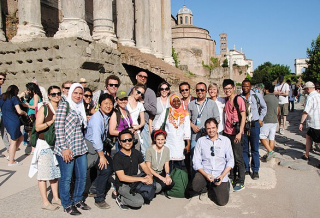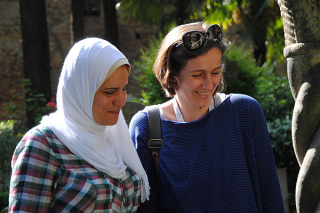As we move into the seventh week of the International Course on Stone Conservation, participants are spending more time together, extending their knowledge and strengthening new friendships. They are currently travelling through Italy, visiting the World Heritage sites of Florence, Pisa, Parma and Venice. They have studied traditional carving techniques at a sculpture studio in Carrara and visited the marble quarries there, and they have had the chance to see ongoing conservation projects at Pisa and the Rialto Bridge in Venice. Another highlight was the two days of hands-on activities at the conservation studio of Stefano Volta in Collecchio, near Parma, where participants tested cleaning and pre-consolidation treatments on different stone types, and carried out pinning and gluing of broken stone.
In the previous weeks, participants were taken to exclusive places in Rome such as the Vatican Laboratories and Papal Gardens, as well as the conservation site at Santa Maria Antiqua in the Roman Forum, where they looked at conservation issues posed by humidity with professor Ippolito Massari and conservator Werner Schmidt.
Since the course started, participants have discussed a number of controversial yet common aspects of stone conservation both in the classroom and in the laboratory. What do we conserve – materials, their appearance, their intrinsic and historical values? Practical sessions at the Non-Catholic Cemetery in Rome and all this new knowledge are helping them as they make conservation choices regarding the application of methods and materials, and as they develop documentation systems and write conservation proposals and reports.
Marija and Nashwa give us their viewpoints
To give you a better idea of what taking our Stone Course is like, we have interviewed two participants, Marija and Nashwa, who are working together on the tomb of Edward St. J Malet at the Non-Catholic Cemetery.
What is the most important topic you have come across so far during the course?
Marija: Even though until now there were many topics within the Stone Conservation Course which I found very interesting and important, when asked to point out the MOST interesting one, I would highlight the lectures on moisture and water by Ippolito Massari. Being a conservator and not an architect or an engineer, I found it very interesting to look at the building and the surrounding as a whole, instead of focusing on the surface and looking at only details.
Nashwa: Mortar is the most important topic. For me, it is very beneficial to know the different kinds and the characteristics of lime. Also, recognizing the main components of mortars through the analysis of the historic mortars, and how to mix them for various purposes was relevant to me. This topic helps in the preparation of suitable mortars for the masonry. In addition, learning more about moisture is a very important topic, as well as determining moisture sources and its effects on stone. Finally, I understood better how to control moisture in stone masonry and how this plays an important role in built heritage conservation.
How do you think you will be applying this knowledge and experience in the future?
Marija: In his lecture Ippolito Massari showed us the possible sources of water, but also pointed out very clearly how one can differentiate between them. Some of the analyses are very simple and I think these can be easily incorporated into projects. So, I hope that the next time I am confronted with a “water problem”, I will be able to understand the problem as well as the source better and to recognize possible solutions. Last but not least, I hope that I can incorporate some of the ideas he presented in my work with students back in Vienna.
Nashwa: Indeed, I will apply this knowledge to my daily work due to the scarcity of experts in this field in Gaza. This technical information will enormously develop our efficiency at work. Also, I will use this knowledge as a background for understanding and implementing future conservation projects.
Naswha and Marija working on their tomb at the Non-Catholic Cemetery.
Marija is from the Former Yugoslav Republic of Macedonia and works in Austria. She supervises training programs in stone conservation at the University of Applied Arts Vienna, from where she has obtained a degree in Conservation in 2006. She is currently involved in the conservation of the UNESCO World Heritage Site, ‘Royal Palace in Patan’ in Nepal. This multinational project is a collaboration with the Katmandu Valley Preservation Trust (Nepal), the El En Group (Italy) and the National Museum Institute (India).
Nashwa, from Palestine, is a site supervisor in architectural conservation projects in Gaza. Her academic background is in Architectural Engineering. She is supervising the conservation of Elsaqqa Historical House in cooperation with the Riwaq Centre for Architectural Conservation in Ramallah, funded by the Swedish International Development Agency (SIDA) and UNESCO.
The International Course on the Conservation of Stone is offered in partnership with the Getty Conservation Institute.


